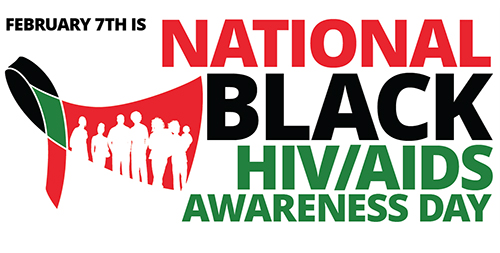FOR IMMEDIATE RELEASE
Media Contact:
Joana Casas, amfAR
(212) 806-1602
joana.casas@amfar.org
Six Things You Need to Know for National Black HIV/AIDS
Awareness Day
National Black HIV/AIDS Awareness Day Is February 7

New York, February 2017 --- National Black HIV/AIDS Awareness Day, observed every year on February 7, is a good time to remind the general public of the racial disparities in HIV infection that persist in the United States. Year after year, African-Americans continue to shoulder the heaviest burden of HIV. Here are six things you need to know about the epidemic’s impact on African-Americans:
Black Americans account for nearly half of all new HIV infections each year, despite representing only 13 percent of the U.S. population. Black Americans are at higher risk of HIV exposure, not because they engage in more risk-associated behaviors, but because the prevalence of HIV is so much greater among black communities than among any other racial/ethnic group. While prevention efforts have helped reduce the annual number of new HIV diagnoses among African-Americans over the last decade, progress has not been uniform across the black community.
It is estimated that around 14 percent of black Americans living with HIV do not know they are infected. National Black HIV/AIDS Awareness Day is an HIV testing and treatment community mobilization initiative for African-Americans. A late diagnosis of HIV infection is common in African-American communities, which results in missed opportunities to get early medical care and prevent transmission to others.
One in two black gay men nationally will be diagnosed with HIV in their lifetime. Black gay men continue to be at highest risk for HIV among African-Americans and all other groups nationwide.While the overall HIV infection rate among black Americans is around two percent, among black gay men the rate is 30 percent, and 1 in 2 black gay men are expected to be diagnosed with HIV in their lifetime. Recent data from the Centers for Disease Control and Prevention (CDC) also show that new HIV diagnoses are increasing among black gay men and other men who have sex with men (MSM), despite overall decreases in the general population.
HIV rates among black women in the U.S. have declined. According to the CDC,the number of new HIV diagnoses among black women fell 42 percent from 2005 to 2014. Despite these gains, new HIV diagnoses among black women are still high compared to women of other races/ethnicities; black women accounted for six in 10 diagnoses among all women in 2014. CDC also estimates that one in 48 black women will be diagnosed with HIV in their lifetime.
Black transgender women are more likely to have HIV than transgender women of other races/ethnicities. A 2009 National Institutes of Health study of transgender women in the U.S. showed that more than 56 percent of black trans women were HIV-positive.
Black Americans are still more likely to die from HIV/AIDS compared to other groups. According to the CDC, black Americans account for almost half of all those with AIDS who have died in the U.S. since the beginning of the epidemic. While the AIDS death rate among blacks declined 28 percent from 2008 to 2012, it was 13 percent higher than whites and 47 percent higher than Latinos.These racial disparities persist despite the fact that AIDS mortality rates have declined sharply overall since the advent of more successful therapies.
Underlying Factors That Fuel the HIV/AIDS Epidemic Among Blacks
Discrimination, stigma, poverty, and lack of access to healthcare contribute to the disproportionate burden of HIV among black Americans.This is most notably the case in regions with large black populations like the American South where approximately half of the nation’s new HIV infections occur, with black Americans accounting for nearly 80 percent of them. In general, African-Americans are less likely than whites to have private health insurance.
“If you don’t have access to healthcare and you’re HIV-positive, you’re less likely to be on medication or virally suppressed, and therefore more likely to transmit HIV,” said amfAR Vice President and Director of Public Policy Greg Millett. “We also have to do a better job of reducing HIV stigma because it keeps people from being tested for HIV, and it keeps people who are HIV-positive from seeking care because they’re afraid they’ll be discriminated against. And that is what continues to fuel the epidemic.”
According to Millett, to effectively address the racial disparities in the HIV/AIDS epidemic in the U.S., we need to continue raising awareness about how HIV disproportionately affects the black community, urge our policymakers to prioritize HIV prevention and treatment resources to the hardest hit communities, such as black gay men, and improve care for HIV-positive black women and injecting drug users.
For more information about HIV/AIDS and amfAR, visit www.amfar.org.
For more information about National Black HIV/AIDS Awareness Day visit: https://nationalblackaidsday.org
Read More at A&U Magazine:
Six Things You Need to Know for National Black HIV/AIDS Awareness Day
About amfAR:
amfAR, The Foundation for AIDS Research, is one of the world’s leading nonprofit organizations dedicated to the support of AIDS research, HIV prevention, treatment education, and the advocacy of sound AIDS-related public policy. Since 1985, amfAR has invested $450 million in its programs and has awarded grants to more than 3,300 research teams worldwide.
# # #
Sources:
amfAR, The Foundation for AIDS Research, “HIV and Black Community: Do Black (Gay) Lives Matter?, February 2015, http://www.amfar.org/uploadedFiles/_amfarorg/Articles/On_The_Hill/2016/Black-Gay-Men-and-HIV.pdf
CDC, “Morbidity and Mortality Report: Mortality Among Blacks or African Americans with HIV Infection — United States, 2008–2012”, https://www.cdc.gov/mmwr/preview/mmwrhtml/mm6404a2.htm
CDC, “HIV Among African-Americans,” September 2016, https://www.cdc.gov/hiv/group/racialethnic/africanamericans/; https://www.cdc.gov/nchhstp/newsroom/docs/factsheets/cdc-hiv-aa-508.pdf
Herbst JH, Jacobs ED, Finlayson TJ, et al. the HIV/AIDS Prevention Research Synthesis Team, “Estimating HIV prevalence and risk behaviors of transgender persons in the United States: a systematic review.” AIDS Behavior, 2008; https://www.ncbi.nlm.nih.gov/pubmed/17694429